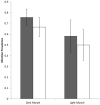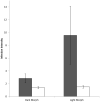Differential haemoparasite intensity between black sparrowhawk (Accipiter melanoleucus) morphs suggests an adaptive function for polymorphism
- PMID: 24391707
- PMCID: PMC3876978
- DOI: 10.1371/journal.pone.0081607
Differential haemoparasite intensity between black sparrowhawk (Accipiter melanoleucus) morphs suggests an adaptive function for polymorphism
Abstract
Recent research suggests that genes coding for melanin based colouration may have pleiotropic properties, in particular conveying raised immune function. Thus adaptive function of polymorphism may be associated with parasite resistance. The black sparrowhawk Accipiter melanoleucus is a polymorphic raptor with two morphs. Over most of its range the light morph is commonest, however within the recently colonised Western Cape of South Africa the dark morph predominates. The species breeds in winter throughout South Africa, however unlike in the rest of the species' South African range, the Western Cape experiences a winter rainfall regime, where arthropod vectors which transmit haematozoan parasites may be more abundant. We hypothesise that the higher frequency of dark morph birds in this region may be due to their improved parasite resistance, which enables them to cope with higher parasite pressure. If so, we predict that dark morph black sparrowhawks would have lower parasite burdens than light morph birds. Within our population the prevalence of the two most common haematozoan parasites was high, with 72% of adults infected with Haemoproteus nisi and 59% of adults infected with Leucocytozoon toddi. We found no difference in prevalence for either parasite between adult morphs, or between chicks of different parental morphs. However, within adults infected with H. nisi, infection intensity was significantly higher in light morphs than dark morphs. This suggests that dark morphs have lower parasite loads than light morphs due to resistance rather than morph-specific habitat exploitation. Greater resistance to Haemoproteus parasites may therefore be one of the mechanisms through which dark morph black sparrowhawks have a selective advantage in this region and may explain why they are most common in our study area. In other regions, the cost to benefit ratio may be in favour of the light morph, where parasites are less abundant or virulent.
Conflict of interest statement
Figures




References
-
- Roulin A (2004) The evolution, maintenance and adaptive function of genetic colour polymorphism in birds. Biological Review 79: 815–848. - PubMed
-
- McGraw KJ, Mackillop EA, Dale J, Hauber ME (2002) Different colors reveal different information: how nutritional stress affects the expression of melanin- and structurally based ornamental plumage. Journal of Experimental Biology 205: 3747–3755. - PubMed
-
- Meunier J, Pinto SF, Burri R, Roulin A (2011) Eumelanin-based coloration and fitness parameters in birds: a meta-analysis. Behavioural Ecology and Sociobiology 65: 559–567.
-
- Ducrest AL, Keller L, Roulin A (2008) Pleiotropy in the melanocortin system, coloration and behavioural syndromes. Trends in Ecology & Evolution 23: 502–510. - PubMed
Publication types
MeSH terms
LinkOut - more resources
Full Text Sources
Other Literature Sources

